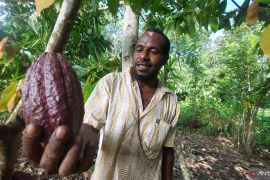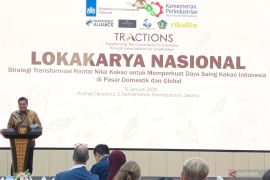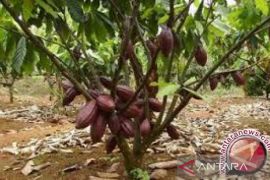For the last 20 years Indonesia was the world`s third largest cocoa producer after Ivory Coast and Ghana, contributing export earnings in excess of US $1.4 billion per year.
In the late 1980s cocoa growing began seriously in the regions of Sulawesi island, and considerably lifted the fortune of cocoa-growing communities over the next two decades.
Therefore, West Sulawesi Governor Anwar Adnan Saleh in the provincial city of Mamuju said on Wednesday that he remained optimistic Indonesia would become the world`s largest coca producer and exporter.
In mid 2008, the Indonesian Government announced a large national program for revitalization of the cocoa industry,known as Gernas Pro Kakao.
"Since the announcement of Gernas Pro Kakao program, I remain optimistic that West Sulawesi is able to turn Indonesia into the largest cocoa producing country," Governor Anwar Adnan said in Mamuju.
He said the program was intended to replace up to 70,000 hectares of cocoa, rehabilitate another 140,000 hectares and intensify farming on 300,000 hectares - bringing the total planted area to around 900,000 hectares of productive cocoa.
The West Sulawesi governor said Ivory Coast at present was the world`s largest cocoa producing country while Indonesia is on the third place, but he was optimistic that the latter will be the first in years to come.
Therefore, in his presentation on national cocoa revitalization program at the National Development Planning Board (Bappenas), Governor Anwar asked that the ongoing program since 2008 be continued until 2014.
"The Gernas Pro Kakao program has a target to improve the production and quality of the commodity to exceed Ivory Coast in 2014," the governor said.
He said West Sulawesi provincial government planned to step up cocoa production every year but it was hampered by the limited amount of budget from the central government.
In 2009 West Sulawesi produced 40,000 tons of cocoa but the production declined in 2010 following the reduction of budget from the central government.
According to the West Sulawesi governor, 80 percent of national cocoa production came from eastern Indonesian regions while the rest come from other provinces such as Bali, East Nusa Tenggara, and Aceh.
Vice Minister of Trade Mahendra Siregar also said Indonesia has a great opportunity to be the largest cocoa producer in the world for its ability to produce cocoa beans in large enough quantities.
According to him, cocoa is the third largest contributor to exports in the exports of agricultural products group.
As the number three producer in the world`s largest cocoa after Ivory Coast and Ghana, he said Indonesia should increase its production of the commodity.
He said that besides boosting the production, the quality of Indonesian cocoa should also be improved because commodity had special characteristics that were not owned by another country.
Indonesia has earlier exported about 80 percent of its cocoa beans, but with the imposition of the export tax, exports could be cut for domestic grinders.
The government hopes that in 2011 its exports of cocoa beans would drop from 80 percent to 50 percent.
The government has since April 1, 2010 imposed a 15 percent tax on cacao bean exports in order to boost local processing industry and increase the added value of farmers cacao production.
About 93 percent of Indonesia`s 1.5 million hectares of cocoa plantations are owned by smallholders.
Since the imposition of the regulation last April, several cacao processing companies have also planned to expand as of 2011 so that next year production of processed cacao is projected to rise to 300,000 tons or they would be able to process almost 50 percent of total national cacao bean production.
According to the Indonesian Cocoa Association, the cocoa bean exports from Indonesia`s main growing region of Sulawesi island increased 2.1 percent last year.
The shipments from the world`s third biggest producer of the chocolate ingredient rose to 280,708 metric tons in 2010 from 274,887 metric tons in 2009, according to data from the association.
"Cocoa output in 2010 didn`t increase much because rainy weather disrupted harvests, and shipments were delayed," Indonesian Cocoa Association spokesman Zulhefy Sikumbang has said.
Sulawesi accounts for about 75 percent of total output and overseas sales of the commodity from the Southeast Asian nation.
Therefore the West Sulawesi governor said the province would continue to maintain its cocoa production as national commodity and to develop it to increase the national economic growth.
He said the cocoa plant would be included into 18 categories of superior commodities to step up the national economic growth.
"The central government earlier did not include cocoa into
18 categories of superior seed plants to be nationally developed in an effort to step up national economic growth," Anwar said.
But he added that West Sulawesi provincial government would maintain cocoa and continue to develop it as a mainstay commodity in this country.
The governor said that following the Indonesian government announcement of a large national program for the revitalization of cocoa industry, known as Gernas Pro Kakao, around 25 provinces in 2011 would implement the program.
"We are optimistic that the Gernas Pro Kakao program for all cocoa production areas in Sulawesi island and almost all eastern Indonesian regions will make Indonesia the world`s largest cocoa producing country," Governor Anwar Adnan Saleh said.(*)
Reporter: Otniel Tamindael
Editor: Aditia Maruli Radja
Copyright © ANTARA 2011











